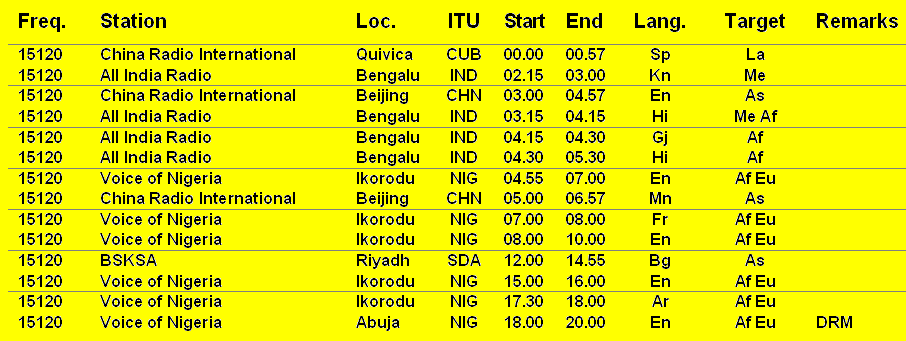

If the radio does not have an RTTY-specific mode, it should be in LSB mode In FSK, the same port can be used for PTT and FSK
RTTY FREQUENCIES LIST SERIAL
Alternatively, you can control PTT from a serial port with a keying circuit. If you use PTT control from N1MM Logger in other modes, the same method can be used in digital modes. If you are using a USB-to-serial adapter, you will probably need to use the EXTFSK plug-in in MMTTYįor either AFSK or FSK, you need some way to control PTT (TX/RX switching).
RTTY FREQUENCIES LIST MANUAL
IC72), in order to receive RTTY you will need to connect the audio output from your radio to the input of the sound card being used with your computer, or if you are using a TNC or TU, to its audio input (see the manual for your TNC/TU for details)įor AFSK, you need to connect the audio output from your sound card or TNC/TU to an audio input on your radio (exception: radios with a built-in USB Codec), either directly or via a sound card interfaceįor FSK, you need a keying circuit from a serial port to your radio’s FSK keying input. Unless your radio has a USB Codec built in (e.g. Here are some tips for RTTY setup and operation:

It is also important to take steps to avoid transmitting extraneous noises or spurious signals. As a result, it is important not to overstress the transmitter. Because the optimum filtering and other settings for RTTY operation are different from those for voice communication, some transceivers offer special AFSK or digital-mode modes, but fundamentally these are the same as SSB.ĭigital modes are harder on transmitting equipment than CW and SSB because of the higher duty cycle (sustained periods of full-power transmitting). AFSK can be used with any SSB transmitter. The second method, using audio tones fed into an SSB transmitter which converts the tones to RF in exactly the same way that SSB converts audio voice frequencies to RF, is called Audio Frequency Shift Keying (AFSK). Radios that support this FSK mode usually have other features that assist RTTY operators, such as specialized filtering. FSK therefore requires an on-off keying interface between the computer and the radio, and the radio must have the internal circuitry required to perform the frequency shifting. This keying is very similar to CW keying, except that instead of turning the carrier on and off as in CW, closing the key input shifts the transmitter’s frequency. The first method (usually called FSK) requires an on-off keying signal to be applied to a keying input to the radio. The frequency shifting can be done either at RF, in radios which support this method, or at audio frequencies. That is, RTTY is modulated using frequency-shift keying (FSK). N1MM Logger, of course, also supports this method of modulating and demodulating RTTY and other digital modes, using a sound-card based digital-mode “engine”.Īn RTTY signal is a single carrier (like CW), but instead of being modulated on and off like CW, the transmitted power is kept constant, and modulation is imposed by changing the frequency by a preset amount in amateur usage, the historical practice is to use a “shift” of 170 Hz. However, with the advent of the ubiquitous sound card-equipped PC, it became possible to perform the modulation and demodulation directly in a personal computer, and the majority of RTTY today is done using a sound card in a PC. TNCs are still in use today, and N1MM Logger supports the use of TNCs for RTTY. The most popular of these units were multi-mode TNCs (Terminal Net Controllers) that supported RTTY in addition to packet radio and other digital modes.

RTTY FREQUENCIES LIST CODE
The first of these terminal units were self-contained microprocessor devices (modems) that converted the 5-bit Baudot code used in RTTY into ASCII characters to be sent to a terminal (keyboard and CRT display). More recently, these mechanical teleprinters have been replaced by other devices. Despite these constraints, RTTY has proven to be quite well-adapted to contesting, and it is still by far the most common digital contesting mode. This equipment posed severe constraints on the RTTY mode that are still evident today. If you are an old-timer at RTTY, you can probably skip this section.īefore the spread of personal computers, RTTY was the most prevalent digital mode (other than CW, that is!), and was done using surplus teletype equipment – mechanical teleprinters. If you are new to digital mode contesting in general and RTTY in particular, this information may be helpful.

This section contains some general information about operating in RTTY that is not directly related to N1MM Logger. N1MM Logger supports digital mode contesting, not only RTTY but also other digital modes, with a flexible interface. Digital mode contesting is growing rapidly.


 0 kommentar(er)
0 kommentar(er)
